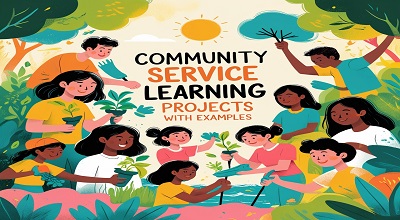Community Service Learning Projects
Community service learning projects are an innovative educational approach that combines academic learning with meaningful community service. These projects not only enhance students’ understanding of academic concepts but also foster a sense of civic responsibility and social awareness. In this article, we will explore the concept of community service learning, and its benefits, and provide examples of impactful projects. Additionally, we will address frequently asked questions to help educators and students better understand this approach.
What is Community Service Learning?
Community service learning, often referred to as service-learning, is an educational strategy that integrates community service with academic instruction. It emphasizes critical thinking, problem-solving, and reflection to enrich the learning experience while addressing real-world societal needs. Unlike traditional volunteerism, service-learning is directly tied to curriculum objectives, ensuring that students apply classroom knowledge to practical situations.
Benefits of Community Service Learning
Community service learning offers numerous benefits for students, educators, and communities. Here are some of the key advantages:
- Enhanced Academic Learning
By applying theoretical knowledge to real-world problems, students gain a deeper understanding of academic concepts. For example, a biology class might study ecosystems and then participate in a local habitat restoration project. - Development of Soft Skills
Service-learning projects help students develop essential skills such as teamwork, communication, leadership, and empathy. These skills are invaluable in both personal and professional contexts. - Civic Engagement and Responsibility
Students become more aware of societal issues and are motivated to contribute to their communities. This fosters a lifelong commitment to civic engagement. - Positive Community Impact
Communities benefit from the efforts of students who address local challenges, such as environmental conservation, education, or public health. - Increased Self-Worth
Participating in meaningful projects gives students a sense of accomplishment and boosts their self-esteem.
Examples of Community Service Learning Projects
Here are some examples of impactful service-learning projects that educators can implement:
- Environmental Conservation Projects
- Habitat Restoration: Students can work with local environmental organizations to restore natural habitats by planting native vegetation and removing invasive species.
- Recycling Campaigns: Organize a school-wide recycling initiative to educate peers about waste management and sustainability.
- Health and Wellness Initiatives
- Health Awareness Campaigns: Create informational materials on topics like mental health, nutrition, or disease prevention and distribute them in the community.
- Fitness Workshops: Partner with local gyms or health professionals to conduct fitness sessions for community members.
- Educational Support Programs
- Tutoring and Mentorship: High school or college students can tutor younger students in subjects like math, science, or reading.
- Book Drives: Collect and distribute books to underprivileged schools or libraries 3.
- Community Beautification Projects
- Park Cleanups: Organize a cleanup day for local parks or public spaces, involving students and community members.
- Mural Painting: Collaborate with local artists to create murals that reflect the community’s culture and values.
- Social Justice and Advocacy
- Awareness Campaigns: Students can create campaigns to raise awareness about issues like homelessness, gender equality, or racial justice.
- Policy Advocacy: Work with local government officials to advocate for policies that address community needs.
- Technology and Digital Literacy
- Tech Workshops: Teach basic computer skills to senior citizens or underserved populations.
- Website Development: Help local non-profits create or improve their websites to enhance their outreach efforts.
How to Implement a Community Service Learning Project?
Implementing a successful service-learning project requires careful planning and collaboration. Here are the steps to get started:
- Identify Community Needs
Work with local organizations, government agencies, or community leaders to identify pressing issues that students can address. - Align with Curriculum Objectives
Ensure that the project aligns with academic goals and enhances students’ understanding of the subject matter. - Develop a Plan
Create a detailed plan that outlines the project’s objectives, timeline, resources, and evaluation criteria. - Engage Stakeholders
Involve students, parents, educators, and community members in the planning and execution of the project. - Reflect and Evaluate
Encourage students to reflect on their experiences and evaluate the project’s impact on both their learning and the community.
Challenges and Solutions in Service Learning
While service-learning projects offer numerous benefits, they can also present challenges. Here are some common obstacles and strategies to overcome them:
- Limited Resources
- Solution: Partner with local businesses or non-profits to secure funding, materials, or expertise.
- Time Constraints
- Solution: Integrate service learning into the existing curriculum to maximize efficiency.
- Lack of Community Engagement
- Solution: Build strong relationships with community stakeholders and involve them in the planning process.
- Student Resistance
- Solution: Highlight the personal and academic benefits of service-learning to motivate students.
FAQs About Community Service Learning Projects
1: What is the difference between community service and service-learning?
Community service involves volunteering to help others, while service-learning integrates community service with academic learning objectives.
2: How can educators ensure that service-learning projects are meaningful?
Educators should align projects with curriculum goals, address genuine community needs, and encourage student reflection.
3: What age groups can participate in service-learning?
Service-learning is suitable for students of all ages, from elementary school to college and beyond.
4: How can students benefit from service-learning projects?
Students gain academic knowledge, develop soft skills, and build a sense of civic responsibility through service-learning.
5: What are some examples of service-learning in higher education?
Examples include engineering students designing sustainable infrastructure for communities or business students creating marketing plans for non-profits.
6: How can schools measure the success of service-learning projects?
Success can be measured through student reflections, community feedback, and the achievement of project objectives.
Summary
Community service learning projects are a powerful tool for fostering academic growth, personal development, and community engagement. By implementing these projects, educators can create meaningful learning experiences that prepare students to become responsible and active citizens.
